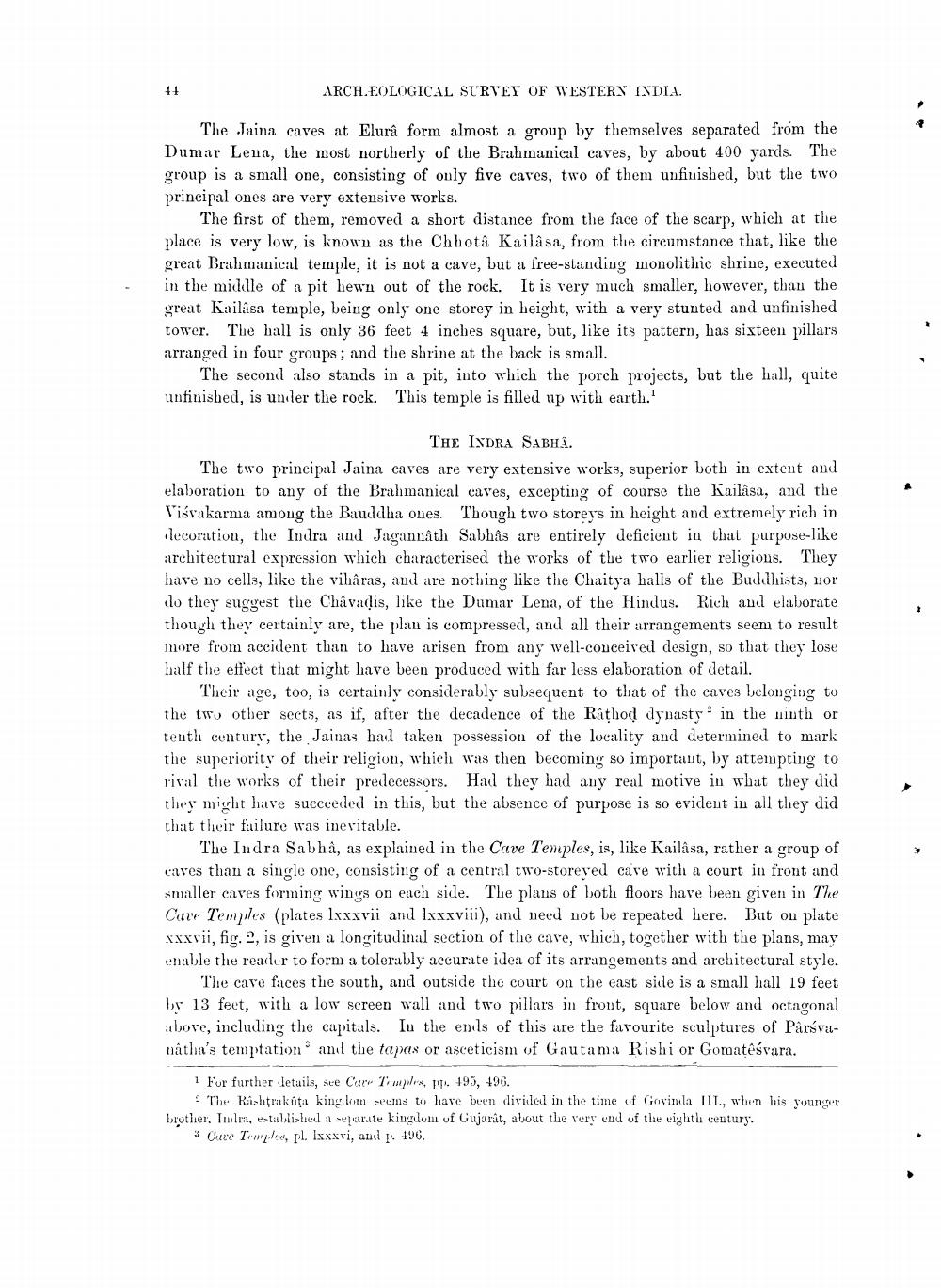________________
ARCHEOLOGICAL SURVEY OF WESTERX INDIA.
The Jaina caves at Elurâ form almost a group by themselves separated from the Dumar Lena, the most northerly of the Brahmanical caves, by about 400 yards. The group is a small one, consisting of only five caves, two of them unfinished, but the two principal ones are very extensive works.
The first of them, removed a short distance from the face of the scarp, which at the place is very low, is known as the Chhota Kailasa, from the circumstance that, like the great Brahmanical temple, it is not a cave, but a free-standing monolithic shrine, executed in the middle of a pit hewn out of the rock. It is very much smaller, however, than the great Kailasa temple, being only one storey in height, with a very stunted and unfinished tower. The hall is only 36 feet 4 inches square, but, like its pattern, has sixteen pillars arranged in four groups; and the shrine at the back is small.
The second also stands in a pit, into which the porch projects, but the hall, quite unfinished, is under the rock. This temple is filled up with earth.
THE ISDRA SABHÂ. The two principal Jaina caves are very extensive works, superior both in extent and elaboration to any of the Brahmanical caves, excepting of course the Kailasa, and the Višvakarma among the Bauddha ones. Though two storeys in height and extremely rich in decoration, the Indra and Jagannath Sabhâs are entirely deficient in that purpose-like architectural expression which characterised the works of the two earlier religions. They have no cells, like the vihâras, and are nothing like the Chaitya halls of the Buddhists, nor do they suggest the Chavadis, like the Dumar Lena, of the Hindus. Rich and elaborate though they certainly are, the plan is compressed, and all their arrangements seem to result more from accident than to have arisen from any well-conceived design, so that they lose half the effect that might have been produced with far less elaboration of detail.
Their age, too, is certainly considerably subsequent to that of the caves belonging to the two other sects, as if, after the decadence of the Rathod dynasty in the ninth or tenth century, the Jainas had taken possession of the locality and determined to mark the superiority of their religion, which was then becoming so important, by attempting to rival the works of their predecessors. Had they had any real motive in what they did they might have succeeded in this, but the absence of purpose is so evident in all they did that their failure was inevitable.
The Indra Sabha, as explained in the Cave Temples, is, like Kailâsa, rather a group of caves than a single one, consisting of a central two-storeyed cave with a court in front and smaller caves forming winys on each side. The plaus of both floors have been given in The Carr Temples (plates lxxxvii and lxxxviii), and need not be repeated here. But on plate xxxvii, fig. 2, is given a longitudinal section of the cave, which, together with the plans, may enable the reader to form a tolerably accurate idea of its arrangements and architectural style.
The cave faces the south, and outside the court on the east side is a small hall 19 feet br 13 feet, with a low screen wall and two pillars in front, square below and octagonal above, including the capitals. In the ends of this are the favourite sculptures of Pårávanatha's temptation and the tapas or asceticism of Gautama Rishi or Gomateśvara.
1 For further details, see Car Temple PT. 195, 196.
9 The Rashtrakúta kinglom seems to have been dividel in the time of Govinda III., when his younger brother. Imma, established a separate kingdom of Gujarat, about the very end of the eighth century:
* Cure Tower, pl. lxxxvi, and. 196.




